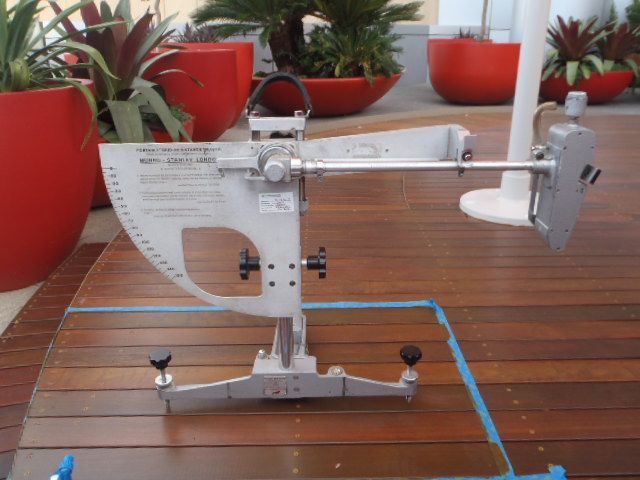
After our first blog about slip resistance of timber and the new building codes, we were pleasantly surprised to receive this response from Adrian Ayris of Ezi Floor Products, who helps to provide more information on the subject to assist industry.
“Dear Carl,
I have been doing some research with regard to slip resistance in relation to the Bona timber floor finishes we distribute here in AU and ‘fell’ across your recent series of documents relating to the changes in legislation and building codes. You raised a few questions in the undernoted article and whilst I can’t pretend to represent the industry I have had a lot of experience which means that I may be able to shine some light on where timber floor finishes sit in relation to the subject.
SLIP RESISTANCE OF TIMBER & NEW BUILDING CODES
by Carl Strautins
in Building Codes, Timber & Wood
I think that it might be useful to give a little background so that you can understand where I am coming from. Whilst working in the industry both in Europe and here I have been on the distribution side for country distributors at times, as now, and at other times working directly for Bona doing international technical support / development. I have also worked dealing with other building products such as timber treatment materials, damp proofing materials and general building chemicals. Bona sell in over 70 countries around the world and when I was working for them I was on various development committees looking at trying to provide the products that the industry needed to satisfy both the ‘decorative’ demands and the legislative hurdles. With that many countries as you might appreciate it is a difficult juggling act particularly with regard to legislation. Aesthetics follow a well-worn path around the world so it just takes a little longer for a trend to appear in one place or another.
Looking at your document I think that it kind of illustrates the major difference between timber floor finishes and other flooring materials which then makes quite clear why the legislation is so hard for finishes to comply with. I’ll try to split things into two areas and then proceed from there.
Externally it should be possible to deal with pretty much any requirement for decking and stairs by making the surface of the wood rougher and then using oil to give the illusion of protection against weathering and some consideration towards aesthetics. The reality is that it is the substrate in this situation that controls the slip resistance. Leave it sanded more roughly and the deck will more textured and therefore more slip resistant. How you can test that I really don’t know though. The difficulty will be that any sample can be manipulated to pass the test but then the actual installation is totally out of the hands of the specifier and manufacturer. Plus of course the actual slip resistance will vary greatly through the life of the floor depending upon the amount of oil, the amount of rain, etc., etc. We don’t sell oils at present but will in the future and I am sure that we would be able to put together a specification that can meet various different scenarios for slip resistance for external decking and stairs simply by varying the level of sanding completed.
Internal timber flooring is unfortunately a different kettle of fish… First off the scene needs to be set as to what people want as opposed to what the Standard is trying to force them to have. People want their flooring, in both commercial and domestic situations, to be part of the decorative nature of the room with choices of sheen level and appearance. They need to be easy to clean, hard wearing, scratch resistant and easy to restore in the future with minimal down town and cost. There may be a few minor variables to that picture but that broadly brings it together in a reasonably neat package. They accept that they want it to have a level of slip resistance and that this may need to vary for different uses but that should not affect the original parameters that they have set
We have already been dealing with the existing requirements of HB197 for commercial buildings so we have a reasonable idea of the issues that are faced and broadly understand the reasoning as to why it is thought necessary to introduce ‘protective’ measures against slip, although on a practical level with 30 years of flooring experience the amount of problems related to the actual floor surface as opposed to poor maintenance is something difficult to quantify and I feel certain that if floors were maintained properly the amount of slippage would be hugely reduced.
95% of all timber floor finishes available in the world will not achieve R9 / 10 or X / P3. The vast majority will have been on the market for many years with no problems being reported but they are unsuitable for use – remember it is a commercial world and it is impossible to sell a product that is not fit for purpose as the liabilities are so high nowadays that companies would not proceed.
There are 3 ways to get around the problem:
- Leave the raised grain of the timber still evident on the surface of the floor to give a textured surface.
- Add plastic aggregate into the penultimate coat of finish so leaving a textured surface to the floor
- Take ultra matt finishes and add an additive to try to increase the wet slip resistance of the finish whilst maintaining a smooth to the touch finish film
Unfortunately all 3 approaches bring their own problems:
Raised grain on the surface of the floor affects the appearance greatly. The floor looks poor and there is no evenness of sheen. If you fall on to the floor the type of texture will cut and snag skin and clothes. It would be impossible for instance to walk up a set of stairs in your socks or with bare feet. The surface also retains the dirt making it look very grubby very quickly + the level of cleaning needed wears the floor more quickly and flattens the grain thus changing the slip resistance. So as a solution externally with oil and not a surface building finish this can work but not internally.
This method is the easy shortcut for manufacturers and there are some companies that are suggesting that their finishes can achieve even up to R12 which puts a smile on my face as internal places where you had a floor needing R12 couldn’t sustain a timber floor and certainly not one that you would want to coat. The downside with this method is that you have a textured surface with all of the issues that brings + the efficacy is totally down to the contractor with regard to the quantity of aggregate added, distribution in the finish and the coverage rates of the product applied. It is fine to walk on in shoes but not so pleasant if specified for a floor in a childcare centre or for your stairs at home. It is a smooth texture, unlike 1. but it still holds dirt within the texture. It feels vaguely like the outside of a golf ball with wider spacing if you want to visualise it. The downside with it holding dirt is twofold. If a floor is dirty then the slip resistance is a moveable feast that will vary depending upon how good the cleaning is – if you are not standing on the floor then it matters little how slip resistant it is. Secondly, if the cleaning is good then often the floor starts to wear more quickly because the cleaners are ‘rubbing’ the surface harder to remove the dirt. Bearing in mind that the majority of commercial floors will be in entrance areas or pubs and clubs then you can see that cleaning is a major issue. It is already harder to clean a floor that is slip resistant because the mop, still the most popular way to clean small commercial floors, simply isn’t easy to push over a floor that essentially ‘pushes’ back to stop the mop slipping across the surface. So now it is harder still and one of the easiest costs to cut in times of financial tightening is cleaning so already cleaning can be perfunctory at best. All of this assumes of course that the floor hasn’t simply been cleaned with the wrong cleaner or that polish hasn’t been applied.The next thing is that the floor needs to be recoated more often if it is being ‘worn’ or dulled by cleaning. Unfortunately now you need 2 coats to be applied because the aggregate has to go in the first coat and then be covered by a 2nd ‘protective’ coat. If you were a pub, club or office owner and you could see this happening then of course the temptation is to go for just the ordinary finishes because you won’t get these problems.
So, we have had products that we can sell that meet the requirements of the various Standards pre late 2013 but they contradict the needs and desires of the specifiers by forcing them to have very matt surfaces + there is a premium in price. The major advantages they have is that they are smooth to touch, easy to recoat and easy to maintain + the products come ready to go so there is no input from the contractor as to the quality of the product.
I think that the difficulty for coatings is that all end users expect and want a smooth easily cleaned and restored finish whereas for pretty much every other flooring type the level of slip resistance can be set at the point of manufacture and there is no expectation of a perfectly smooth surface like a table top. The technology for meeting slip resistance Standards with coatings has evolved slightly but it isn’t predictable in the same way as a factory produced material can be. Changes in the curing conditions can easily affect the performance of a finish whereas making a ceramic tile can be totally controlled.
So, not an official representative of the timber floor coating industry I have explained the situation with some broad brush strokes and you have a better appreciation of the issues that we in the timber finishing industry face.”
We thank you for your time to response Adrian.
if you have comments that you would like to share to assist others in our industry, please feel free to post here or call to discuss further.
Author: Carl Strautins

Email: Carl@SafeEnvironments.com.au
Web: www.SafeEnvironments.com.au
As a principle at Safe Environments, Carl Strautins first started his career at CSIRO conducting research in slip resistance and developed the accelerated wear slip resistance test. He holds a degree in materials science, masters in occupational health and safety and a masters in science in occupational hygiene, Carl provides guidance to industry to minimise the risk of slip and fall incidents. He is engaged on a regular basis to provide expert opinion for disputes and legal proceedings.

